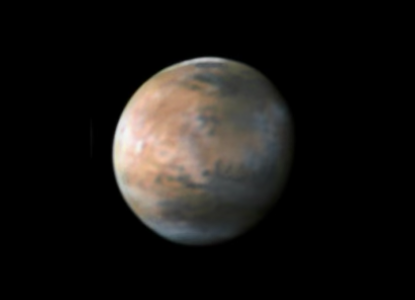Maevetheeuropan - Maeve The Europan

More Posts from Maevetheeuropan and Others
Solar System: Things to Know This Week
In addition to the Mercury transit of the sun today, there are a few other things you should know about our solar system this week:
1. Mars, Ready for its Close-Up

Mars will soon be closer to Earth than it has been for 11 years, presenting a great opportunity for backyard sky watchers.
2. Fire and Ice

Our spacecraft have an even closer view of Mars, and that fact regularly leads to some intriguing discoveries. The latest: volcanoes may have erupted beneath an ice sheet there billions of years ago. The above image is a mineral map of part of the Martian surface.
3. Icy Hydra

Meanwhile, our New Horizons spacecraft has sent home the first compositional data about Pluto’s four small moons. The new data show the surface of Hydra is dominated by nearly pristine water ice–confirming hints that scientists picked up in images showing Hydra’s highly reflective surface.
4. Ceres, Ever Sharper

The mission director for our Dawn mission writes, “Ceres, which only last year was hardly more than a fuzzy blob against the stars, is now a richly detailed world, and our portrait grows more elaborate every day.”
5. Join us at Jupiter

Our Juno mission arrives at the giant planet on Jul. 4. Meanwhile, all amateur astronomers are invited to take part in a worldwide effort to identify potential observations for the spacecraft to make once it’s in orbit. Find out how to join HERE.
Want to learn more? Read our full list of the 10 things to know this week about the solar system HERE.
Make sure to follow us on Tumblr for your regular dose of space: http://nasa.tumblr.com
Space Station Research: Cardiovascular Health
Each month, we highlight a different research topic on the International Space Station. In February, our focus is cardiovascular health, which coincides with the American Hearth Month.
Like bones and muscle, the cardiovascular system deconditions (gets weaker) in microgravity. Long-duration spaceflight may increase the risk of damage and inflammation in the cardiovascular system primarily from radiation, but also from psychological stress, reduced physical activity, diminished nutritional standards and, in the case of extravehicular activity, increased oxygen exposure.

Even brief periods of exposure to reduced-gravity environments can result in cardiovascular changes such as fluid shifts, changes in total blood volume, heartbeat and heart rhythm irregularities and diminished aerobic capacity.

The weightless environment of space also causes fluid shifts to occur in the body. This normal shift of fluids to the upper body in space causes increased inter-cranial pressure which could be reducing visual capacity in astronauts. We are currently testing how this can be counteracted by returning fluids to the lower body using a “lower body negative pressure” suit, also known as Chibis.
Spaceflight also accelerates the aging process, and it is important to understand this process to develop specific countermeasures. Developing countermeasures to keep astronauts’ hearts healthy in space is applicable to heart health on Earth, too!

On the space station, one of the tools we have to study heart health is the ultrasound device, which uses harmless sound waves to take detailed images of the inside of the body. These images are then viewed by researchers and doctors inside Mission Control. So with minimal training on ultrasound, remote guidance techniques allow astronauts to take images of their own heart while in space. These remote medicine techniques can also be beneficial on Earth.
Make sure to follow us on Tumblr for your regular dose of space: http://nasa.tumblr.com








The Solar System!

bonus Pluto!
Okay now that I’m starting to get my ass in gear for astrophotography, I’d love it if some of y’all sated my need for attention and followed my instagram! I will return the favor of course
It’s mostly just space pictures, dogs, me, hiking stuff and lab stuff

Scientists invented fabric that makes electricity from motion and sunlight. To create the fabric, researchers at Georgia Tech wove together solar cell fibers with materials that generate power from movement. It could be used in “tents, curtains, or wearable garments,” meaning we’d virtually never be without power. Source

Mars Orbiter Mission: April 11, 2016 Clouds over Olympus Mons, April 11th 2016
Olympus Mons is a large shield volcano on the planet Mars. It has a height of nearly 22 km. Olympus Mons stands almost three times as tall as Mount Everest’s height above sea level. It is the youngest of the large volcanoes on Mars, having formed during Mars’s Amazonian Period. Several meteorological factors contribute to cloud formation. This MCC image was taken on April 11, 2016 at an altitude of 22,794 km and resolution of 1,185 meters. The image shows cloud around Olympus Mons Region.
LOL oh @claraxbarton you know me SO well!
I’ve totally got the first ep on my DVR - I just haven’t had time to watch it lol
@maevemauvaise !!!!!!!!!!!!
SpaceX Sends Super Science to Space Station!
SpaceX is scheduled to launch its Dragon spacecraft PACKED with super cool research and technology to the International Space Station June 1 from Kennedy Space Center in Florida. New solar panels, investigations that study neutron stars and even fruit flies are on the cargo list. Let’s take a look at what other bits of science are making their way to the orbiting laboratory 250 miles above the Earth…

New solar panels to test concept for more efficient power source
Solar panels generate power well, but they can be delicate and large when used to power a spacecraft or satellites. This technology demonstration is a solar panel concept that is lighter and stores more compactly for launch than the solar panels currently in use.

Roll-Out Solar Array (ROSA) has solar cells on a flexible blanket and a framework that rolls out like a tape measure and snap into place, and could be used to power future space vehicles.
Investigation to Study Composition of Neutron Stars
Neutron stars, the glowing cinders left behind when massive stars explode as supernovas, contain exotic states of matter that are impossible to replicate in any lab. NICER studies the makeup of these stars, and could provide new insight into their nature and super weird behavior.

Neutron stars emit X-ray radiation, enabling the NICER technology to observe and record information about its structure, dynamics and energetics.
Experiment to Study Effect of New Drug on Bone Loss
When people and animals spend lots of space, they experience bone density loss. In-flight exercise can prevent it from getting worse, but there isn’t a therapy on Earth or in space that can restore bone that is already lost.

The Systemic Therapy of NELL-1 for osteoporosis (Rodent Research-5) investigation tests a new drug that can both rebuild bone and block further bone loss, improving health for crew members.
Research to Understand Cardiovascular Changes
Exposure to reduced gravity environments can result in cardiovascular changes such as fluid shifts, changes in total blood volume, heartbeat and heart rhythm irregularities, and diminished aerobic capacity.

The Fruit Fly Lab-02 study will use the fruit fly (Drosophila melanogaster) to better understand the underlying mechanisms responsible for the adverse effects of prolonged exposure to microgravity on the heart. Fruit flies are effective model organisms, and we don’t mean on the fashion runway. Want to see how 1,000 bottles of fruit flies were prepared to go to space? Check THIS out.
Space Life-Support Investigation
Currently, the life-support systems aboard the space station require special equipment to separate liquids and gases. This technology utilizes rotating and moving parts that, if broken or otherwise compromised, could cause contamination aboard the station.

The Capillary Structures investigation studies a new method of water recycling and carbon dioxide removal using structures designed in specific shapes to manage fluid and gas mixtures.
Earth-Observation Tools
Orbiting approximately 250 miles above the Earth’s surface, the space station provides pretty amazing views of the Earth. The Multiple User System for Earth Sensing (MUSES) facility hosts Earth-viewing instruments such as high-resolution digital cameras, hyperspectral imagers, and provides precision pointing and other accommodations.

This investigation can produce data that could be used for maritime domain awareness, agricultural awareness, food security, disaster response, air quality, oil and gas exploration and fire detection.
Watch the launch live HERE! For all things space station science, follow @ISS_Research on Twitter.
Make sure to follow us on Tumblr for your regular dose of space: http://nasa.tumblr.com
Solar System: Things to Know This Week
There’s even more to Mars.

1. Batten Down the Hatches
Good news for future astronauts: scientists are closer to being able to predict when global dust storms will strike the Red Planet. The winds there don’t carry nearly the same force that was shown in the movie “The Martian,” but the dust lofted by storms can still wreak havoc on people and machines, as well as reduce available solar energy. Recent studies indicate a big storm may be brewing during the next few months.
+ Get the full forecast

2. Where No Rover Has Gone Before
Our Opportunity Mars rover will drive down an ancient gully that may have been carved by liquid water. Several spacecraft at Mars have observed such channels from a distance, but this will be the first up-close exploration. Opportunity will also, for the first time, enter the interior of Endeavour Crater, where it has worked for the last five years. All this is part of a two-year extended mission that began Oct. 1, the latest in a series of extensions going back to the end of Opportunity’s prime mission in April 2004. Opportunity landed on Mars in January of that year, on a mission planned to last 90 Martian days (92.4 Earth days). More than 12 Earth years later, it’s still rolling.
+ Follow along + See other recent pictures from Endeavour Crater

3. An Uphill Climb
Opportunity isn’t the only NASA Mars rover getting a mission extension. On the other side of the planet, the Curiosity rover is driving and collecting samples amid some of the most scenic landscapes ever visited on Mars. Curiosity’s two-year mission extension also began Oct. 1. It’s driving toward uphill destinations, including a ridge capped with material rich in the iron-oxide mineral hematite, about a mile-and-a-half (two-and-a-half kilometers) ahead. Beyond that, there’s an exposure of clay-rich bedrock. These are key exploration sites on lower Mount Sharp, which is a layered, Mount-Rainier-size mound where Curiosity is investigating evidence of ancient, water-rich environments that contrast with the harsh, dry conditions on the surface of Mars today.
+ Learn more

4. Keep a Sharp Lookout
Meanwhile, the Mars Reconnaissance Orbiter continues its watch on the Red Planet from above. The mission team has just released a massive new collection of super-high-resolution images of the Martian surface.
+ Take a look

5. 20/20 Vision for the 2020 Rover
In the year 2020, Opportunity and Curiosity will be joined by a new mobile laboratory on Mars. In the past week, we tested new “eyes” for that mission. The Mars 2020 rover’s Lander Vision System helped guide the rocket to a precise landing at a predesignated target. The system can direct the craft toward a safe landing at its primary target site or divert touchdown toward better terrain if there are hazards in the approaching target area.
+ Get details
Discover the full list of 10 things to know about our solar system this week HERE.
Make sure to follow us on Tumblr for your regular dose of space: http://nasa.tumblr.com
-
 maevetheeuropan reblogged this · 8 years ago
maevetheeuropan reblogged this · 8 years ago -
 claraxbarton liked this · 9 years ago
claraxbarton liked this · 9 years ago -
 maevemauvaise reblogged this · 9 years ago
maevemauvaise reblogged this · 9 years ago -
 maevemauvaise liked this · 9 years ago
maevemauvaise liked this · 9 years ago -
 shyandpacified-blog liked this · 9 years ago
shyandpacified-blog liked this · 9 years ago -
 fullmetalelf liked this · 9 years ago
fullmetalelf liked this · 9 years ago -
 esgaril liked this · 9 years ago
esgaril liked this · 9 years ago -
 pertaterswithcheese liked this · 9 years ago
pertaterswithcheese liked this · 9 years ago -
 naxoxhide reblogged this · 9 years ago
naxoxhide reblogged this · 9 years ago -
 naxoxhide liked this · 9 years ago
naxoxhide liked this · 9 years ago -
 the-crimson-scythe liked this · 9 years ago
the-crimson-scythe liked this · 9 years ago -
 kiwi-k73-blog liked this · 9 years ago
kiwi-k73-blog liked this · 9 years ago -
 horsegirlpov liked this · 9 years ago
horsegirlpov liked this · 9 years ago -
 pionicorg reblogged this · 9 years ago
pionicorg reblogged this · 9 years ago




